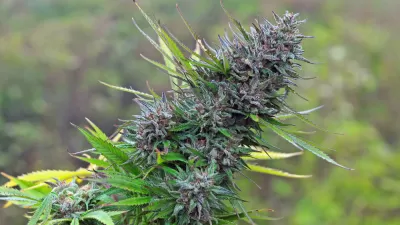The Northern California marijuana industry is booming, but issues with water consumption and downstream pollution produced by the large-scale cultivation of marijuana are threatening populations of salmon already on the brink of extinction.
The environmental impacts of the recent boom in marijuana growing operations have prompted calls for stronger regulation of the business of cultivating marijuana. At stake is the protection of multiple species of salmon, which has dwindled to the brink of extinction along the North Coast of California. “As many as a half-million Chinook salmon once spawned in the Eel River each year. By the 1950s, the fish were almost gone. Since then, the population has slightly rebounded, and several thousand Chinook now return to the Eel annually,” reports Alastair Brand. Dave Bitts, a Humboldt County commercial fisherman and the president of the Pacific Coast Federation of Fishermen's Associations is quoted describing the importance of maintaining watersheds as habitat for salmon: "There is no salmon-bearing watershed at this point that we can afford to sacrifice."
The impacts of marijuana cultivation on watersheds are at least twofold. First, there is the process’s water supply requirements. According to Brand, “Growers of marijuana often withdraw water directly from small streams and use up to six gallons per day per plant during the summer growing season.” Growers might be cultivating as many as 20,000 or 30,000 plants in one watershed.
The effluents produced by marijuana growers poses another risk: “Fertilizers that drain into rivers can cause floating carpets of algae to grow in the water. When these mats begin to decay, the breakdown process steals oxygen from the water, suffocating fish."
FULL STORY: California's Pot Farms Could Leave Salmon Runs Truly Smoked

Planetizen Federal Action Tracker
A weekly monitor of how Trump’s orders and actions are impacting planners and planning in America.

Map: Where Senate Republicans Want to Sell Your Public Lands
For public land advocates, the Senate Republicans’ proposal to sell millions of acres of public land in the West is “the biggest fight of their careers.”

Restaurant Patios Were a Pandemic Win — Why Were They so Hard to Keep?
Social distancing requirements and changes in travel patterns prompted cities to pilot new uses for street and sidewalk space. Then it got complicated.

San Francisco Suspends Traffic Calming Amidst Record Deaths
Citing “a challenging fiscal landscape,” the city will cease the program on the heels of 42 traffic deaths, including 24 pedestrians.

California Homeless Arrests, Citations Spike After Ruling
An investigation reveals that anti-homeless actions increased up to 500% after Grants Pass v. Johnson — even in cities claiming no policy change.

Albuquerque Route 66 Motels Become Affordable Housing
A $4 million city fund is incentivizing developers to breathe new life into derelict midcentury motels.
Urban Design for Planners 1: Software Tools
This six-course series explores essential urban design concepts using open source software and equips planners with the tools they need to participate fully in the urban design process.
Planning for Universal Design
Learn the tools for implementing Universal Design in planning regulations.
Heyer Gruel & Associates PA
JM Goldson LLC
Custer County Colorado
City of Camden Redevelopment Agency
City of Astoria
Transportation Research & Education Center (TREC) at Portland State University
Camden Redevelopment Agency
City of Claremont
Municipality of Princeton (NJ)





























